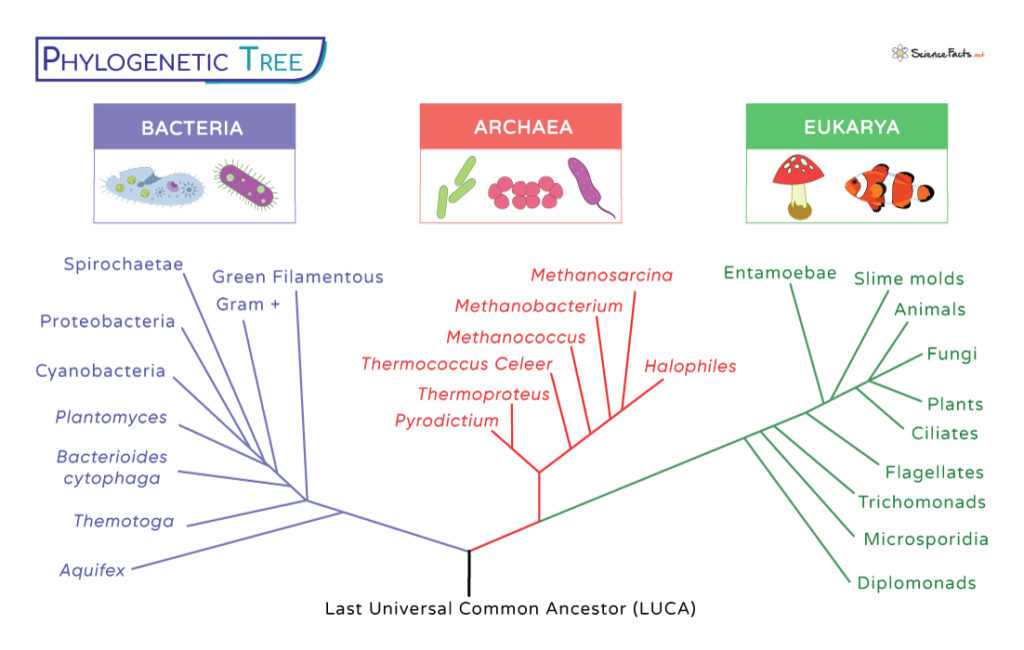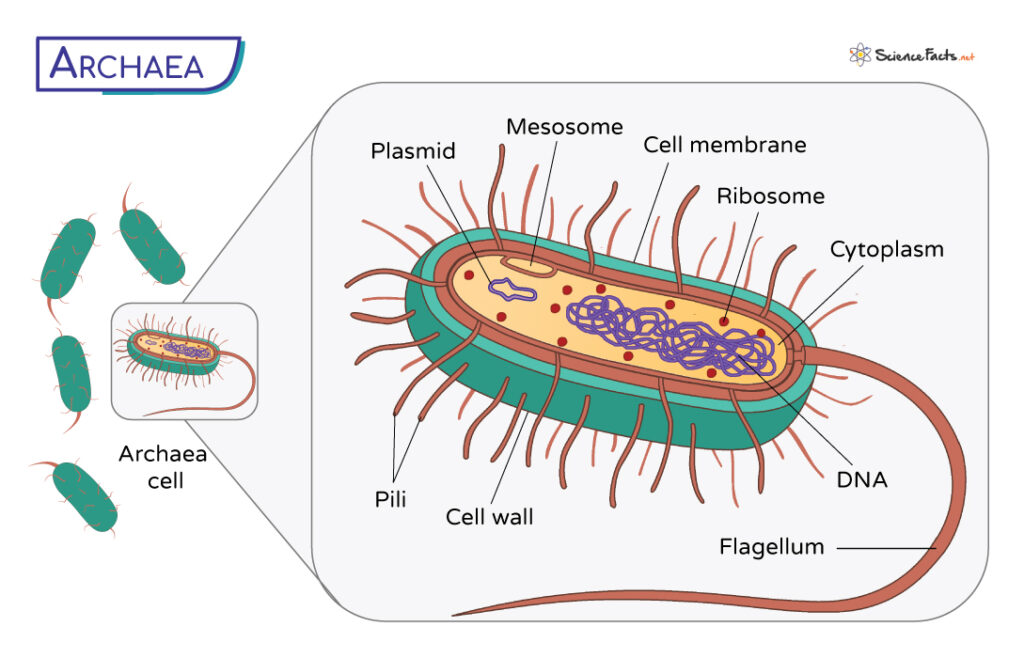Archaea
Archaea, formerly known as ‘archaebacteria,’ are a group of single-celled, prokaryotic organisms belonging to the domain Archaea. Apart from Archaea, Bacteria and Eukarya are the other two domains of life that currently exist.
The Discovery of the Kingdom Achaea
Until the 20th century, all living organisms were classified as plants or animals. However, organisms like fungi, protists, and bacteria could not be placed into either of the domains. Thus, this classification system lost popularity in the 1950s and 1960s.
This disparity led to the ‘Five-kingdom classification’ system developed by Robert Whittaker in the 1960s, which could classify all living organisms. At the elementary level, there were five kingdoms – Monera, Protista, Fungi, Plantae, and Animalia. Of these, only the kingdom Monera was found to be inhabited by prokaryotic organisms, and the other four were eukaryotic kingdoms.
In the 1970s, when Dr. Carl Woese and his colleagues were studying the relationships among the different prokaryotic organisms, he discovered distinctly different organisms that lived at extreme conditions like high temperature, high salinity, and high pressure and produced methane.
Later, those organisms were found to have a completely different genetic makeup, though similar in cell structure to bacteria under a microscope. Woese named them Archaebacteria.
In 1977, Woese proposed that living organisms be divided into three domains: Eukaryota, Eubacteria, and Archaebacteria. Archaebacteria represented separate evolutionary lines of descent that diverged at a very remote point from an ancestral colony of organisms. He later changed the term ‘Archaebacteria’ to ‘Archaea’ as the former was a misnomer.
Taxonomy and the Domain ‘Archaea’ with Examples
The term ‘archaea’ was derived from the Greek word ‘arkhaios’ which means ‘primitive’. Based on the current classification, organisms are classified into three domains and six kingdoms.
The domain ‘archaea’ is further divided into three phyla: Crenarchaeota, Euryarchaeota, and Korarchaeota.
- Crenarchaeota consists of hyperthermophilic and thermoacidophilic organisms. Hyperthermophiles live in extremely hot or cold environments, whereas thermoacidophiles live in scorching and acidic environments. Sulfolobus acidocaldarius is an example of this group.
- Euryarchaeota consists of halophiles and methanogens. Halophiles live in salty habitats, while methanogens require an oxygen-free environment and produce methane as their metabolic byproduct. Halobacterium spp. and Methanococcus spp. belong to this group.
- Korarchaeota are a group of thermophilic organisms living in hot springs. Candidatus spp. belong to this group.
Characteristics of Archaea
Morphology (Size and Shape)
Like bacteria, they are unicellular and come in various shapes like cocci (round) and bacilli (rod-shaped), while some are even irregular, like Crenarchaeota with needle-shaped filaments. They typically range in size from 0.1 to 15 micrometers in diameter.
Composition of Cell Wall and Cell Membrane
The cell walls of archaea exhibit diversity, often differing from those of bacteria in that they lack peptidoglycan. While some archaea possess cell walls made of pseudopeptidoglycan, others lack a traditional cell wall.
The lipid bilayers in archaea comprise branched-chain lipids with ether linkages, in contrast to the ester-linked lipids in bacteria and eukaryotes. In some archaea like Ferroplasma, the lipid bilayer is replaced by a monolayer where the tails of two independent phospholipid molecules are joined into one with two polar heads.
Archaea lipids are chemically distinct from others in that they are made of the isoprene side chain with cyclopropane or cyclohexane rings.
An invagination of the cell membrane called mesosomes is also found in archaea, like in a bacteria cell.
Habitat
Archaea live in various environments, including extreme environments once considered sterile, as found in the genus Halobacterium. These environments consist of high temperatures, often above 100°C, such as in geothermal springs, hydrothermal vents on the ocean floor, black smokers, oil wells, and highly acidic or alkaline lakes and hypersaline environments like the Dead Sea. Hyperthermophilic archaea like Methanopyrus kandleri survive at 122ºC, the highest for any living organism.
Others live in highly acidic environments, like the Picrophilus torridus, which lives at almost pH 0, while others are found in frigid ocean environments, including polar seas.
Metabolism
Archaea display diverse metabolic pathways that harness energy from various sources.
Some archaea use inorganic compounds such as ammonia and sulfur as their energy source and are lithotrophs. Others employ the sun’s energy without using oxygen-based photosynthesis, a group known as phototrophs. They produce ATP from the energy derived from the sun by developing an electrochemical gradient and using ATP synthase, just like a eukaryotic cell.
Some archaea, such as methanogens, are swamp dwellers that rely on carbon dioxide as an electron acceptor to oxidize hydrogen. Alcohols and acetic or formic acid are also used as methanogenic electron acceptors. Acetotrophic archaea that produce biogas decompose acetic acid to methane and carbon dioxide. Few autotrophic archaea also use atmospheric carbon dioxide to fix carbon involving a modified form of the Calvin Cycle or the 3-hydroxypropionate/4-hydroxybutyrate cycle pathway.
How Do They Reproduce
Archaea reproduce through a variety of methods. Since they have no nucleus, they commonly reproduce by binary fission, where a mother cell divides into two genetically identical daughter cells. In some cases, more than two daughter chromosomes form through multiple fission. Some archaea also engage in budding, where a smaller cell (bud) forms on the parent cell before eventually detaching. Unlike bacteria, archaea are found not to form spores.
Histones and DNA
Like eukaryotes, archaea histones help in DNA packing and compaction. However, unlike eukaryotes, histones here do not form discrete nucleosomes; instead, they coil into slinky shapes. The replication also starts from multiple points, resembling eukaryotic replication. However, their protein FtsZ mediated cell division, forming a contractile ring around the cell, and the components of the septum are similar to a bacterium. Archaea also contain extrachromosomal DNA or plasmid.
Protein Synthesis
Like other prokaryotes, archaea produce their proteins using ribosomes that translate mRNA. The ribosomes are composed of a 30s and a 50s subunit, where the former is made of 16S rRNA, and the latter consists of 23S and 5S rRNAs.
Motility
The flagella of archaea are similar in function to those of bacteria. Rotary motors drive them at the base, charged by an electrochemical gradient across the membrane.
Archaea and Human Diseases
While archaea are generally considered harmless, they share a few characteristics with some pathogens.
Studies suggest that higher levels of methane production are linked to conditions like irritable bowel syndrome (IBS) and constipation. Investigation is going on to study the presence of archaea in the oral cavity and its potential role in periodontal diseases. Some studies have even detected them in dental plaques and periodontal pockets.
FAQs
Ans. No, being prokaryotic cells like bacteria, archaea do not have mitochondria.
-
References
Article was last reviewed on Thursday, October 19, 2023





